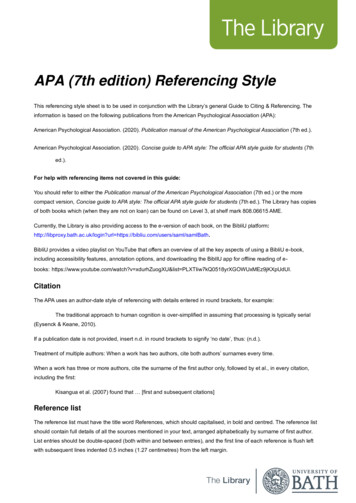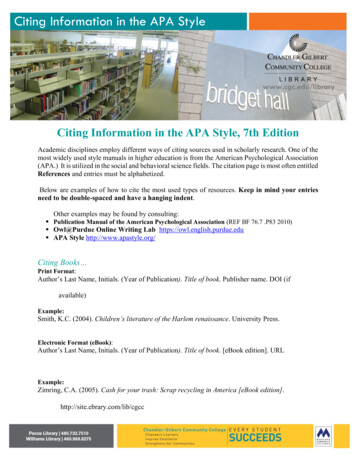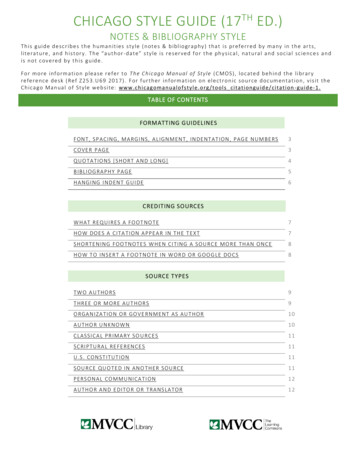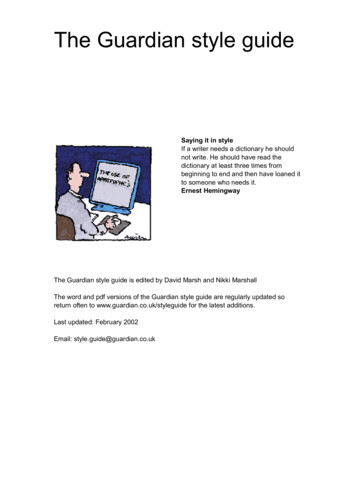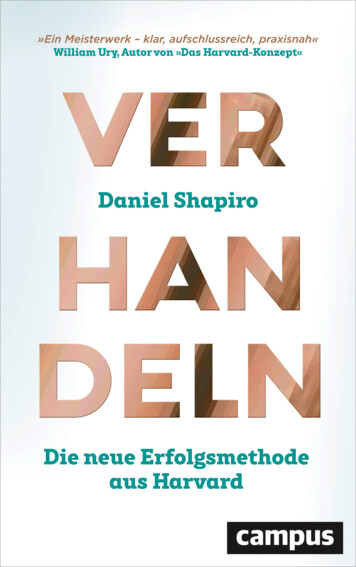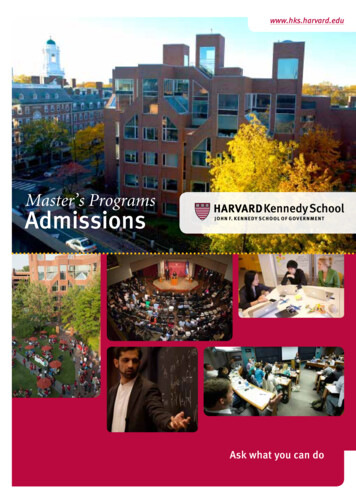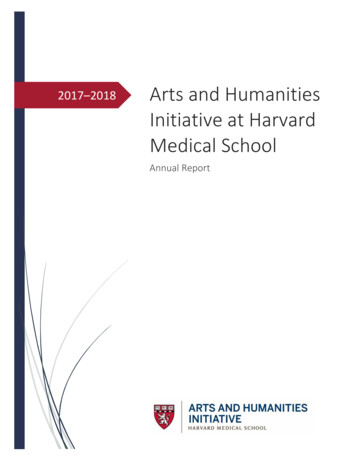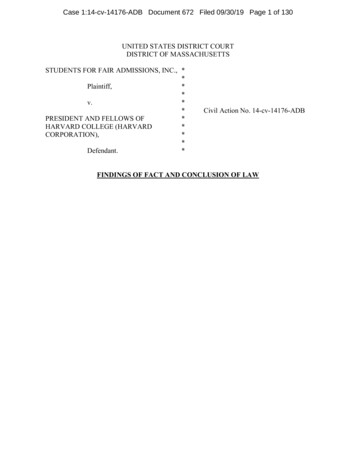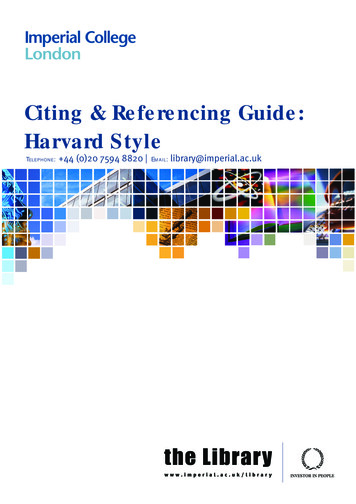
Transcription
Citing & Referencing Guide:Harvard StyleTelephone: 44(0)20 7594 8820 Email: library@imperial.ac.uk
ContentsWhat is Referencing?2Why do it?2How many steps are there to Referencing?2What is Citing?2How to do it – Citing2Reference list5Bibliography5Layout for: Books6 Chapters in books6 E-Books6 Books that have been translated7 Books written in a foreign language7 Journal articles7 E-journal articles7 Theses8 Newspaper articles8 Conference proceedings9 White and Green papers9 Statutory Instruments9 Patents10 Standards10 Reports10 Maps10 WWW10 Podcasts11 Weblogs11 Emails11 Multi-media11 – 12 Personal communication12 Interviews12 Presentations/lectures132nd Edition – September 2007
Please Note: There are different versions of Harvard referencing and this booklet is only a guide;if you have any doubts about your referencing you should always check with your lecturer.What is Referencing?Referencing is how you acknowledge that you have used the ideas and written material belonging to otherauthors in your own work. It demonstrates for example, that you have undertaken an appropriate literaturesearch and that you have carried out appropriate reading. The following are examples of sources you mightaccess and need to reference: Books; Journal articles; Electronic journal articles; World Wide Web pages, picture galleries, images, and diagrams; Emails; Video, films, CD-ROMs & audio tape recordings; Newspapers; Conference papers; Pamphlets; Radio/TV broadcasts (you must check that your lecturer is happy for you to use this type of material inyour assignment); Personal communication; Interviews (If this is a personal interview, you must always ask permission of the interviewee beforeusing such material); and, Theses and other academic work.There are several styles that can be used to reference source material. This guide describes the Harvardreferencing system, which uses and ‘alphabetical-by-author’ approach.Why do it? So that anyone reading your assignments can trace the sources you have used in the development ofyour work, and give you credit for your research efforts and quality; If you do not acknowledge another writer’s work or ideas, you could be accused of plagiarism; and, Accurate referencing is commensurate with good academic practice and enhances the presentation ofyour work: it shows that your writing is based on knowledge instead of guess work or mere opinion.How many steps are there to Referencing?Only two; citing and the referencing list. You must do both parts.What is Citing?When, in your assignment, you have used an idea from a book, journal article, etc. you must acknowledge this inyour text. We refer to this as ‘citing’.How to do it – CitingCiting in the body of your textWhen you cite someone else’s work, you must always state the author/editor and the date of publication. If thework has two authors/editors you must cite both names when citing in the body of your own work. Only use theauthor and date; do not include the title, place of publication, etc., because these full details of the item arewritten in your reference list at the end of your essay.2
Example – 1 Author cited in the body of your text:The work of Smith (2001) emphasises that the research done by Holstein was in direct conflict with thatproduced by Greene.Example – 2 Authors cited in the body of your text:The work of Theakston & Boddington (2001) emphasises that the research done by Holstein was in directconflict with that produced by Greene.If the work has three or more authors/editors the abbreviation ‘et al.’ should be used after the first author’s name.Example:The work of Smith et al. (2001) emphasises that the research done by Holstein was in direct conflict withthat produced by Greene. Theakston & Boddington (2001) however, considered that .If you cite a new source which has the same author and was written in the same year as an earlier citation, youmust use a lower case letter after the date to differentiate between the two.Example – Same author, same year but different work:The work of Smith (2001a) emphasises that the research done by Holstein was in direct conflict with thatproduced by Greene.Citing from chapters written by different authorsSome books may contain chapters written by different authors. When citing work from such a book, the authorwho wrote the chapter should be cited, not the editor of the book.Secondary referencingSecondary references are when an author refers to another author’s work and the primary source is not available.When citing such work the author of the primary source and the author of the work it was cited in should be used.Example – Citing an author who has cited another author:Ellis (1990) cited by Cox (1991) discusses .NB: Secondary referencing should be avoided if possible. Try to find the primary source.Quoting in the textOften it is better to paraphrase than to use direct quotes. This demonstrates that you have understood themeaning and context of what you have read. If a direct quote from a book, article, etc., is used you must: Use single quotation marks (double quotation marks are usually used for quoting direct speech), and, State the page number.Example – Short quotation:Simpson (2002: p.6) declared that ‘the explosive behaviour was unexpected.’ Have a separate, indented paragraph for quotes over two lines.Example – Long quotation:Boden (1998: p.72) states:In 1664, ‘The most common female crime prosecuted at the Quarter Sessions was thatof battering men. This would suggest that women were not the passive and obedientmembers of society that men would have liked to believe they were.’3
Alternatively ‘In 1664 the most common female crime prosecuted at the Quarter Sessions was that ofbattering men. This would suggest that women were not the passive and obedientmembers of society that men would have liked to believe they were.’(Boden 1998: p.72)Alternatively Part of the original text may be omitted from the quotation as long as three dots are used to indicate this.Example – Indicating that some words are ommitted from the quotation:Boden (1998: p.72) states:‘In 1664 the most common female crime prosecuted at the Quarter Sessions was that ofbattering men women beating or dominating a man was a particularly sensitive issue as itthreatened the perpetuation of the patriarchal society ’Duplication of charts, diagrams, pictures etc. should be treated as direct quotes in that the author(s) should beacknowledged and page numbers shown; both in your text where the diagram is discussed or introduced, an inthe caption you write for it.Citing and quoting from multi-media and online resourcesElectronic journal (e-journals) articles:When citing from an e-journal article it should be treated in the same way as a paper journal, using the author’ssurname and the publication date.World Wide Web (WWW): If the website has an obvious author and date of publication, the information should be cited like a bookor journal article. If there is not an obvious author, but the work is situated on an organisational website, the organisation can beused as a ‘corporate author’.Example – Corporate author:The Department of Health (2001)If there is no author or corporate author use the title of the document as the main point of reference.CD-ROMs:If there is not an obvious author use the title of the CD-ROM as the main point of reference.Example:Encyclopaedia Britannica (2001)Multi-media:If a video/DVD recording or audio-cassette is cited, the series title should be used as the ‘author’.Example:World in Action (2002)Citing from an interview or personal communicationWhen citing from an interview always use the surname of the interviewee/practitioner.4
Reference listThis is your list of all the sources that have been cited in the assignment. The list is inclusive showing books,journals, etc., listed in one list, not in separate lists according to source type. The list should be in alphabetical order by author/editor. Books, paper journals articles, e-journal articles, etc., are laid out in a particular format that must be followed.Your reference list contains all the items you have cited or directly quoted from.Example of a reference list page at the end of your written coursework item.Reference ListEdelson, S. (no date) Asperger’s Syndrome. [Online] Available from:http://www.autism.org/asperger.html [Accessed 19th September 2002].Life on Campus. (2006) [DVD] London, Imperial College London.Picard, J. (2001) Logistics and the Borg. Starbug Tribune, 36 (3), 44 – 49.Rymer, J., Smith, T. & Jones, E. (2001) Nottingham Forest – Dream Team.London, Blackwell.World in Action. (1995) All work and no play. [Video: VHS] London, ITV, 21st January.The layout for each type of publication can be found on pages 6 – 12. If you are using the bibliographicsoftware Refworks, you should use the ‘Imperial College London – Harvard’ style which follows the sameformat as this guide.BibliographyThere may be items which you have consulted for your work, but not cited. These can be listed at the end ofyour assignment in a ‘bibliography’. These items should be listed in alphabetical order by author and laid out inthe same way as items in your reference list. If you can cite from every source you consulted, you will only needa reference list. If you wish to show to your reader (examiner) the unused research you carried out, thebibliography will show your extra effort.5
Layout:What information must I collect about my source when I do my research? When I have collected it, what layoutshould I use to present it in my reference list?Books – you need to collect the following details about your source:Author/Editor (if it is an editor always put (ed.) after the name)(Year of publication)Title (this should be in italics)Series title and number (if part of a series)Edition (if not the first edition)Place of publication (if there is more than one place listed, use the first named)PublisherYou present that information as follows:Layout examples:Autistic Association. (2002) Understanding Autism. London, Campion.Kirk, J. (ed.) (1999) Worlds Apart. Florida, Enterprise.Rymer, J. (2001) Nottingham Forest – Dream Team. London, Blackwell.If there are three or more authors you must list every author in your reference list – do not use et al.Layout example:Simpson, H., Jones, E. & Miles, C. (2002) The History of Springfield. 2nd edition.Derby, Bugle Press.Chapters in books – details to collect:Author of the chapter(Year of publication)Title of chapter followed by, In:Editor (if it is an editor always put (ed.) after the name)Title (this should be in italics)Series title and number (if part of a series)Edition (if not the first edition)Place of publication (if there is more than one place listed, use the first named)PublisherPage numbers (use ‘p.’ before a single page number and ‘pp.’ where there are multiple pages)Layout example:Stone, T. (2002) Libraries in the Twenty-First Century. In: Woolley, M. (ed.) TheChanging World of Information Retrieval. Luton, UOL Press, pp. 23 – 45.E-BooksAuthor/Editor (if it is an editor always put (ed.) after the name)(Year of publication)Title (this should be in italics)Edition (if not the first edition)[e-book]Place of publication (if there is more than one place listed, use the first named)PublisherAvailable from: URL[Date of access]Layout example:Jones, E & Miles, C. (2002) Computing Networking. 2nd edition. [e-book] Derby,Bugle Press. Available from: ccessed 10th July 2007].6
Books that have been translatedAuthor/Editor (if it is an editor always put (ed.) after the name)(Year of publication)Title (this should be in italics)Trans (followed by the name of the person who translated the book)Series title and number (if part of a series)Edition (if not the first edition)Place of publication (if there is more than one place listed, use the first named)PublisherLayout example:Kawanishi, M. (2002) The History of Japan. Trans. Bean, S. Hakodate,Hakodate Publishing.Books written in a foreign languageAuthor/Editor (if it is an editor always put (ed.) after the name)(Year of publication)Title (this should be in italics)[Title in original language] (this should be in italics)Series title and number (if part of a series)Edition (if not the first edition)Place of publication (if there is more than one place listed, use the first named)PublisherLayout example:Milani, F. (2001) The Phantom of the Opera. [Le Fantome De L’Opera]Paris, LeRoux.Journal articlesAuthor/Editor(Year of publication)Title of journal articleTitle of journal (this should be in italics)Volume numberIssue numberPage numbers of the article (do not use ‘p’. before the page numbers)Layout example:Picard, J. (2001) Logistics and the Borg. Starbug Tribune, 36 (4), 44 – 49.E-journal articlesAuthor(Year of publication)Title of journal articleTitle of journal (this should be in italics)[Online]Volume numberIssue numberPage numbers of the article (do not use ‘p’. before the page numbers)Available from: URL[Date of access]Layout example:Smith, B. (2002) Time to go Home. Journal of Hyperactivity, [Online] 6 (3),122 – 123 Available from: http://www.alu.ac.uk [Accessed 6th June 2002].7
Theses(Final written work by PhD and postgraduate students, dissertations, project reports, discourses and essays byany student.)Author(Date of publication)Title (this should be in italics)Type of thesisAcademic institutionLayout example:Anderson, C. R. (1996) Local government in transition: LCC to GLC 1962 – 1967.PhD thesis. University of Luton.N.B. Publishers may vary in their use of capital letters in titles. You should always follow the format of thepublication you are referring to.Newspaper articlesPaper copyReporter(Day, month and year of publication)Title of articleTitle of newspaper (this should be in italics)Page numbers of the article (use ‘p.’ before a single page number and ‘pp.’ where there are multiple pages)Layout example:Klingon, J. (Friday 3rd October 2002) Starfleet Command. Startrek News. p. 27.Online copyReporter(Day, month and year of publication)Title of articleTitle of Newspaper (this should be in italics)[Online]Page numbers of the article (use ‘p.’ before a single page number and ‘pp.’ where there are multiple pages)Available from: URL[Date of access]Layout example:Paakkinen, Jouni. (Wednesday 16th October 2002) All Singing, All Dancing. TheSpringfield Times. [Online] Available from: http://www.snpp.com/news.html#songbook [Accessed 15th November 2002].N.B. Some publishers just use the initial of the first name of author(s)/editor(s), others may use the full name.Always follow the format of the publisher you are referring to. If there is no author/editor use the name of thenewspaper as a corporate author.8
Conference proceedingsPublished conference proceedings with author or editor(s):Author/Editor (if it is an editor always put (ed.) after the name)(Year of publication)OrganisationTitle (this should be in italics)Place of publicationPublisherLayout example:Ryker, W. (2002) Federation Council. The astrologics of warp engines.Aberdeen, FCP.N.B. If there is no author/editor use the organisation as a corporate author.Paper in conference proceedings:Author(Year of publication)Title of conference paper followed by, In:Author/Editor (if it is an editor always put (ed.) after the name)OrganisationTitle of conference proceeding (this should be in italics)Place of publicationPublisherPage numbers (use ‘p.’ before a single page number and ‘pp.’ where there are multiple pages)Layout example:Grigio, P. (2002) Aphides and the Pasqua grape. In: Rosemount, T. (ed.) WASS.Proceedings of the 5th annual conference. Florida, Florida Press. pp. 56 –78.White and Green papers(Government consultation papers to inform the debate on new policy and laws.)Government department(Year of publication)Title (this should be in italics)Paper numberPlace of publicationPublisherLayout example:Department of Health. (2004) Choosing Health: making healthier choiceseasier. CM6374. London, Stationery Office.Statutory Instruments(Documents detailing the rules written by the civil service under powers delegated from parliament.)Title (this should be in italics)(Year of publication)The abbreviation: SIStatutory Instrument numberPlace of publicationPublisherLayout example:The Public Contract Regulations 2006. (2006) SI 2006/5. London, TSO (TheStationery Office).9
PatentsAuthor(Year of publication)Title (this should be in italics)Patent number(Patent)Layout example:Wetting, W. (1995) Fluke board variant of surf board – has extension in shape oflobe of dolphin’s tail attached by joint to underside of board. DE4412911-A1 (Patent).StandardsName of Standard Body/Institution(Year of publication)Standard numberTitle (this should be in italics)Place of publicationPublisherLayout example:British Standards Institution (1998) BS 5950-5:1998. Structural use of steelworkin building: code of practice for design of cold formed thin gauge sections. London, BSI.ReportsAuthor(Year of publication)Title (this should be in italics)OrganisationReport number: (this should be followed by the actual number in figures)Layout example:Leatherwood, S. (2001) Whales, dolphins, and porpoises of the western NorthAtlantic. U.S. Dept. of Commerce. Report number: 63.MapsAuthor(Year of publication)Title (this should be in italics)ScaleSeries title and number (if part of a series)Place of publication (if there is more than one place listed, use the first named)PublisherLayout example:Geographical Survey of Great Britain. (1972) Brighton. 1:50.000. London,AA Publishing.WWWAuthor/Editor(Year)Title (this should be in italics)[Online]Available from: URL[Date of access]Layout example:Edelson, S. (no date) Asperger’s Syndrome. [Online] Available from:http://www.autism.org/asperger.html [Accessed 19th September 2002].10
PodcastsTitle (this should be in italics)(Year)Podcast[Online]Available from: URL[Date of access & GMT] (this should include hours, minutes & seconds)Layout example:Nature Podcast. (2006) Podcast. [Online]Available from: essed 25th May 2006. GMT 18:11:06].WeblogsAuthor/Corporate Author(Year)Title (this should be in italics)Weblog[Online]Available from: URL[Date of access & GMT] (this should include hours, minutes & seconds)Layout example:Tyler, R. (2006) The Mechanical Interface of the Tardis. Weblog. [Online]Available from: http://www.darlikcity.org/publication3.html [Accessed 19thApril 2006. GMT 07:49:37].N.B. If there is no author or corporate author use the title of the document as the main point of reference.EmailsSender(Sender’s email address)(Day-Month-Year)Subject of message (this should be in italics)E-mail to: recipients name(Recipient’s email address)Layout example:Hornblower, H. (h.hornblower@HMS.Renown.uk) (16th May 2002) Treaty ofLuneville. E-mail to: Pellew, C. (c.pellew@HMS.Justinian.uk).Multi-mediaVideo recordings – recorded from the TV:Layout example:World in Action. (1995) All work and no play. [Video: VHS] London, ITV, 21stJanuary 1996.Video recordings – commercial:Layout example:Fragile Earth, 5. (1982) South American Wetland: Pantanal. [Video: VHS] Henley,Watchword Video.Layout example:Life on Campus. (2006) [DVD] London, Imperial College London.DVD:Audio cassettes:Layout example:British Diabetic Association. (2002) Guidelines on Nutrition. [Audio Cassette]London, BDA.11
CD-ROMs:Author/Editor (if no author is available use ‘Anon’)(Year of publication)Title of information usedCD-ROM title (this should be in italics)[CD-ROM]Place of publicationPublisherLayout example:James, A. (2002) Heart Attack. Encyclopaedia Britannica. [CD-ROM] London,Encyclopaedia Britannica.Films:Title of film (this should be in italics)(Year)[Film]DirectorPlace of production and production companyLayout example:Harry Potter and the Chamber of Secrets. (2002) [Film] Directed by: ChrisColumbus. USA, Warner Brothers.Personal communicationName of PractitionerOccupation(Personal communication and date information was provided)Layout example:Law, James. Engineering consultant. (Personal communication, 26th April 2004).InterviewsBroadcast interviews:Name of person interviewedInterviewed by: Name of interviewerTitle of interview (if any)Title of Programme (this should be in italics)(Date and time)Production informationLayout example:Kirk, T. Interviewed by: Picard, J. News Night Live. (24th June 2001) 10pmChannel 6.Personal interviews:Name of person interviewedInterviewed by: Name of interviewer(Date and time)Layout example:Potter, H. Interviewed by: Snape, S. (24th June 2005).12
Presentations/lecturesAuthor(Year)Title of presentation/lecturePresented at the conference/meeting title (this should be in italics)Conference/meeting locationLayout example:Yoda, M. (2005) Code of Ethics for the Jedi: are they outdated? Presented at theAnnual Jedi Conference. Coruscant.Online version:Author(Year)Title of presentation/lecturePresented at the conference/meeting title (this should be in italics)Conference/meeting location[Online]Available from: URL[Date of access]Layout example:Solo, H. (2004) Light speed and prevailing problems. Presented at the Schoolof Aeronautics. London. [Online] Available from: http://starwars.org.uk[Accessed 20th May 2005].13
Telephone: 44 (0)20 7594 8820Email: library@imperial.ac.ukprinted on 100% recycled paper
When, in your assignment, you have used an idea from a book, journal article, etc. you must acknowledge this in your text. We refer to this as ‘citing’. How to do it – Citing. Citing in the body of your text. When you cite someone else’s work, you must always st

